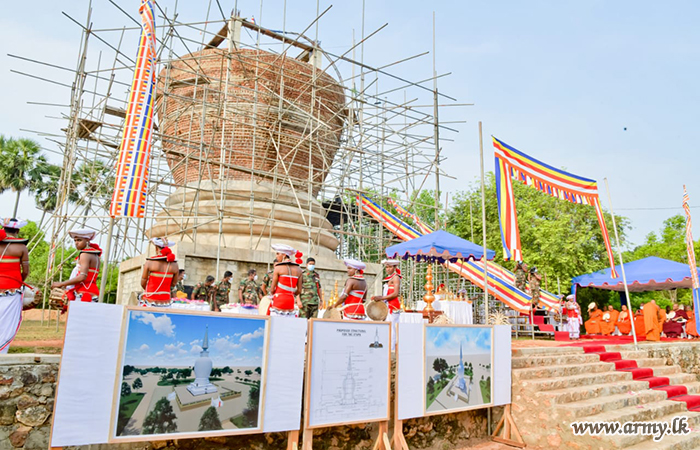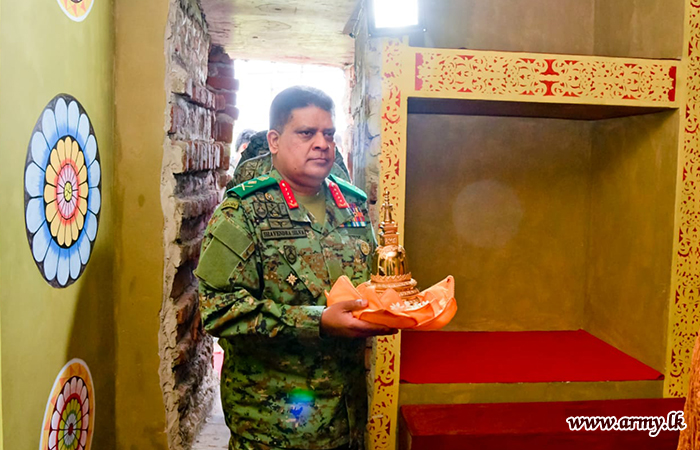
The Tissa Raja Maha Vihara in Thaiyiddy, Jaffna, has become a focal point of controversy and resistance for Tamils in the region, symbolising the Sri Lankan state’s ongoing Sinhalisation efforts. Built illegally on private land, its presence has sparked strong opposition from local Tamils, who continue to demand its removal and the return of their lands.
A brief history
Thaiyiddy is located Kankesanthurai (KKS), in Jaffna, a region that has for decades seen a heavy Sri Lankan military presence.
In the heart of the Eelam Tamil cultural capital, aside from the Sri Lankan occupation it has little to no Sinhala Buddhist presence, a fact that has been the case for decades.
According to TamilNet there was however a brief but small Sinhala Buddhist presence at one point. During British colonial rule, a Sinhala person named Galagama Aratchige Abraham Perera (G.A. Perera) of Udamulle Nugegoda in Colombo made a ‘prior registration’ of 1.25 acre of the land plot in Thaiyiddi, on 18 December 1946.
“The land plot has the traditional Tamil name, U'luththang-kaladdi. After the Sinhala monks started to work there, the place also became known as ‘Sinhala kaladdi’ and as ‘Puththa-koayiladi’.”
“Two monks in Jaffna at that time, Brahmanawaththe Damma Kiththi Thissa Thero of Nayinaa-theevu and Kalutara Pandithaseela Dharatissa Thero of Kaangkeasan-thu'rai (KKS), were named as the purchasers of the land as well as the trustees of the ‘Tissa temple’.”
“However, the small establishment ceased to exist over the years,” with reports suggesting that it stopped functioning all together from 1959 onwards.
The land where the vihara now stands was originally home to Tamil families who were forcibly displaced by the war in 1990. Following their departure, the Sri Lankan military occupied the area and declared it a high-security zone (HSZ). Despite the war ending in 2009, the military continued to restrict access to the area, preventing rightful landowners from returning.
In 2018, then-Northern Governor Reginald Cooray laid the foundation stone for the Tissa Vihara, and the military constructed the shrine the following year. The temple was built on six acres of private Tamil land, without the consent of the landowners or approval from local government authorities. The shrine was erected in an area that was once home to an ancient Vairavar Kovil, a Hindu temple, reinforcing fears of cultural erasure.
The military not only facilitated the construction but also fortified the site, establishing sentry posts and restricting entry, turning the temple into what locals have described as a military encampment.

Despite clear documentation confirming the land’s private ownership, in 2022, General Shavendra Silva, Chief of Defence Staff and Commander of the Army, attended a ceremony to install sacred Buddhist relics at the vihara. Silva is currently barred from entering the US due to his role in war crimes against Tamils.

The following year, Major General Swarna Bothota, Commander of Security Forces (Jaffna), presided over the unveiling of the pinnacle of the reconstructed stupa. The event was guided by Ven. Ginthota Nandarama Thero, the Chief Incumbent of the shrine, underscoring the state-military-Buddhist nexus in the continued encroachment on Tamil lands.
Ongoing land seizures and Buddhist expansion
Tamils in Thaiyiddy are now facing renewed threats as the All Ceylon Buddhist Congress (ACBC) is pushing for the acquisition of an additional eight acres of land to expand the Tissa Vihara. In a letter to the Jaffna District Secretary, the ACBC has insisted that the 14 acres surrounding the vihara, along with the seven acres where it was built, should be formally handed over to them.
The letter further demands that the land be developed into a major Buddhist centre, complete with a Buddhist educational facility, Buddha statues, a Bodhi tree, an alms hall, a monastery, a rest pavilion, a meditation hall, and landscaped gardens. The ACBC has urged the government to take immediate action to facilitate these developments, ignoring the fact that the land legally belongs to Tamil landowners.
Resistance from Tamils
.jpeg)
Tamil politicians have strongly opposed the expansion, with Tamil National People’s Front (TNPF) leader Gajendrakumar Ponnambalam raising the issue in Parliament. He exposed how the ACBC, led by Chandra Nirmal Wakishta, a former Director of the National Intelligence Bureau and a retired senior police officer, is pressuring the government to formalise the land grab.
Ponnambalam also accused the Sri Lankan military of operating with a counter-insurgency mindset, continuing to act with hostility towards the Tamil people even after the end of the war. He condemned the military’s role in illegally constructing the vihara and its continued occupation of Tamil lands under the pretext of national security.
At a District Development Committee meeting in December 2024, chaired by Fisheries Minister R. Chandrasekar, Tamil representatives challenged the state’s actions. The meeting reaffirmed that the shrine was built on private land without approval and was not recognised by local authorities. However, the ACBC has since dismissed the agreement made in the meeting, claiming that the chief monk was not present and thus the decision to return the land was invalid.
ITAK leader S. Shritharan has warned that Tamil landowners, backed by the people of Jaffna, will take action against the illegal construction. Addressing a press conference at the Jaffna Press Club, he questioned why the government allowed a Buddhist shrine to be built on private Tamil land while other unauthorised structures on state land had been removed.
Tamils in Thaiyiddy have been protesting every Poya (full moon) day for more than a year, demanding the removal of the vihara. The 12 acres of land surrounding the shrine belong to 14 Tamil farming families, yet they remain occupied by the military-backed Buddhist establishment.
A broader pattern of Sinhalisation
The Tissa Vihara case is not an isolated incident but part of a broader pattern of Sinhalisation and Buddhist expansion in the Tamil homeland. Successive Sri Lankan governments have facilitated the construction of Buddhist structures on Tamil lands, often with direct involvement from the military.
Ponnambalam has framed this issue as a litmus test of the Sri Lankan government’s commitment to anti-racism. He pointed out that Sri Lankan President Anura Kumara Dissanayake acknowledged in his policy statement that racism still exists. However, he challenged the government to demonstrate real action by addressing cases like the Tissa Vihara land grab.
“The original vihara has a particular plot of land—that land, nobody disputes,” Ponnambalam stated. “But instead, the military, under the guise of a high-security zone, illegally took over six acres of privately owned land and built this temple.”
Despite a 2023 report from the Divisional Secretariat confirming that the temple was built illegally, the military has continued its activities with impunity.
Continued Tamil protests
Despite the ongoing construction, the Tamil people remain resolute in their demand for the land grabs and colonisation to be halted. With protests continuing and Tamil MPs pushing back against these land grabs in Parliament, the issue of the Tissa Vihara remains a key battleground in the fight against Sinhalisation.

.JPG)